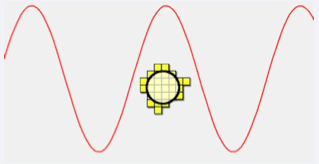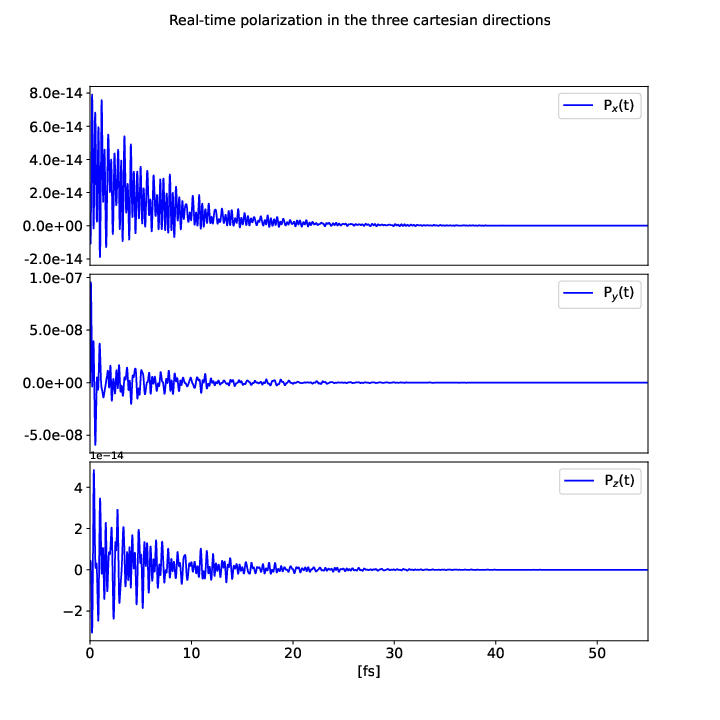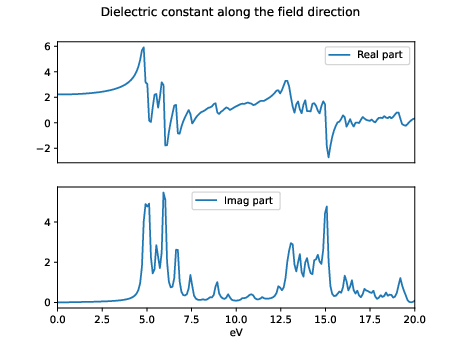Linear response in velocity gauge: Difference between revisions
| Line 76: | Line 76: | ||
from scipy.interpolate import CubicSpline | from scipy.interpolate import CubicSpline | ||
import matplotlib.pyplot as plt | import matplotlib.pyplot as plt | ||
NLDB=YamboNLDB() | NLDB=YamboNLDB() | ||
current =NLDB.Current[0] | current =NLDB.Current[0] | ||
time=NLDB.IO_TIME_points | time=NLDB.IO_TIME_points | ||
Revision as of 14:18, 7 November 2023
In this tutorial we show how to get the linear response using the velocity gauge
instead of the Berry phase approach in length gauge.
We use the same DFT input files of the tutorial Linear response using Dynamical Berry Phase,
run the same setup and remove the symmetries.
Real-time dynamics in velocity gauge
Then in order to calculate the response in velocity gauge we use the command yambo_nl -u p -V resp -F input_lr.in to generate the input:
nlinear # [R NL] Non-linear optics NL_Threads= 1 # [OPENMP/NL] Number of threads for nl-optics % NLBands 3 | 6 | # [NL] Bands % NLstep= 0.0100 fs # [NL] Real Time step length NLtime=55.000000 fs # [NL] Simulation Time NLintegrator= "INVINT" # [NL] Integrator ("EULEREXP/RK4/RK2EXP/HEUN/INVINT/CRANKNIC") NLCorrelation= "IPA" # [NL] Correlation ("IPA/HARTREE/TDDFT/LRC/JGM/SEX/HF") NLLrcAlpha= 0.000000 # [NL] Long Range Correction NLDamping= 0.000000 eV # [NL] Damping RADLifeTime=-1.000000 fs # [RT] Radiative life-time (if negative Yambo sets it equal to Phase_LifeTime in NL) #EvalCurrent # [NL] Evaluate the current #FrPolPerdic # [DIP] Force periodicity of polarization respect to the external field Gauge= "velocity" # [BSE/X] Gauge (length|velocity) % Field1_Freq 0.100000 | 0.100000 | eV # [RT Field1] Frequency % Field1_NFreqs= 1 # [RT Field1] Frequency Field1_Int= 1000.00 kWLm2 # [RT Field1] Intensity Field1_Width= 0.000000 fs # [RT Field1] Width Field1_kind= "DELTA" # [RT Field1] Kind(SIN|COS|RES|ANTIRES|GAUSS|DELTA|QSSIN) Field1_pol= "linear" # [RT Field1] Pol(linear|circular) % Field1_Dir 0.000000 | 1.000000 | 0.000000 | # [RT Field1] Versor % Field1_Tstart= 0.010000 fs # [RT Field1] Initial Time
Notice that in velocity gauge the current is correct while the polarization is calculated using only intra-band dipoles, that anyway is enough for the linear response.
Analysis of the results using YamboPy using polarization
This part works only with Yambo 5.3 or the last version available on Github: https://github.com/yambo-code/yambo
You can get the dielectric constant along the field direction using the same procedure of the Berry Phase case, Fourier transforming the polarization:
import numpy as np from yambopy import * from yambopy.plot import * NLDB=YamboNLDB() pol =NLDB.Polarization[0] time=NLDB.IO_TIME_points t_initial=NLDB.Efield[0]["initial_time"] pol_damped=np.empty_like(pol) for i_d in range(3): pol_damped[i_d,:]=damp_it(pol[i_d,:],time,t_initial,damp_type='LORENTZIAN',damp_factor=0.1/ha2ev) Plot_Pol(time=time, pol=pol_damped, xlim=[0,55], save_file='polarization.pdf')
and then calculate the dielectric constant as in the length gauge
Linear_Response(time=time,pol=-pol_damped,efield=NLDB.Efield[0],plot=False,plot_file='eps.pdf')
notice that in this case, only the linear response along the field is correct.
Analysis of the results using YamboPy using current
The same analysis can be performed using the current. In this case we remove the constant term then we reconstruct the polarization and then the epsilon. This procedure produce a small bump at \omega=0 that is an artifact.
import numpy as np
from yambopy import *
from yambopy.plot import *
from scipy.interpolate import CubicSpline
import matplotlib.pyplot as plt
NLDB=YamboNLDB()
current =NLDB.Current[0]
time=NLDB.IO_TIME_points
t_initial=NLDB.Efield[0]["initial_time"]
#
# Remove the constant term
#
ave_current=np.zeros(3,dtype=np.double)
for i_d in range(3):
ave_current[i_d]=np.sum(current[i_d,:])/current.shape[1]
current[i_d,:]=current[i_d,:]-ave_current[i_d]
pol=np.empty_like(current)
for i_d in range(3):
spline_j=CubicSpline(time,current[i_d,:])
for idx, t in enumerate(time):
pol[i_d,idx]=spline_j.integrate(0.0,t)
#
# There is a wrong sign convention in the velocity gauge
# somewhere in the code
#
pol=-pol
Plot_Pol(time=time, pol=pol, xlim=[0,55], save_file='polarization.pdf')
#
pol_damped=np.empty_like(pol)
for i_d in range(3):
pol_damped[i_d,:]=damp_it(pol[i_d,:],time,t_initial,damp_type='LORENTZIAN',damp_factor=0.1/ha2ev)
#
#
# Calculate the linear response
#
Linear_Response(time=time,pol=pol_damped,efield=NLDB.Efield[0],plot=False,plot_file='eps.pdf' )


